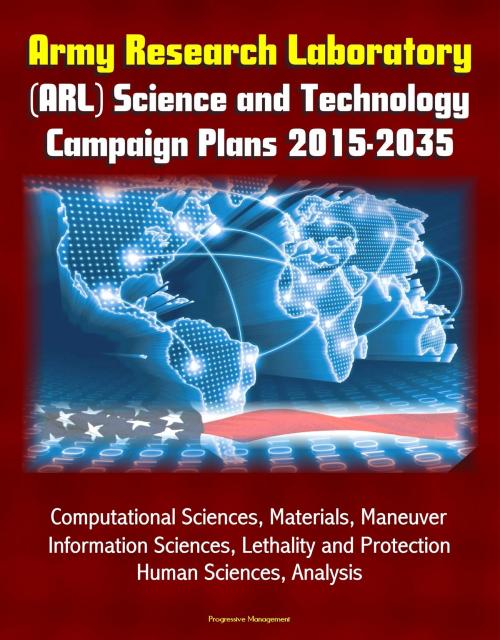Army Research Laboratory (ARL) Science and Technology Campaign Plans 2015-2035 - Computational Sciences, Materials, Maneuver, Information Sciences, Lethality and Protection, Human Sciences, Analysis
Nonfiction, Science & Nature, Technology, Operations Research| Author: | Progressive Management | ISBN: | 9781311246493 |
| Publisher: | Progressive Management | Publication: | April 18, 2015 |
| Imprint: | Smashwords Edition | Language: | English |
| Author: | Progressive Management |
| ISBN: | 9781311246493 |
| Publisher: | Progressive Management |
| Publication: | April 18, 2015 |
| Imprint: | Smashwords Edition |
| Language: | English |
Professionally converted for accurate flowing-text e-book format reproduction, this study provides unique information about the U.S. Army Research Laboratory (ARL), which is the Department of the Army's corporate laboratory, strategically placed within the Army Materiel Command (AMC), an institutional Army Command (ACOM).
ARL is also the Army's sole fundamental research laboratory focused on scientific discovery, technological innovation, and transition of knowledge products; it impacts the Army and broader DoD science and technology (S&T) communities through transition of knowledge products to its sister Research, Development, and Engineering Centers (RDECs) within the Army Research, Development, and Engineering Command (RDECOM) - an AMC Major Subordinate Command (MSC), Army PMs/PEOs, the other services, and industry. ARL executes fundamental research, defined as Basic Research (BA 1) and Applied Research (BA 2), to address enduring S&T challenges that have been identified by the Assistant Secretary of the Army for Acquisition, Logistics, and Technology [ASA(ALT)] and priorities articulated by the Chief of Staff of the Army (CSA). In addition, the laboratory conducts research in emerging fields that hold promise in realization of novel or vastly improved Army capabilities into the deep future; performs research on behalf of other Army activities and, where specifically qualified, for other agencies of the DoD; and, in defense-related efforts, for other government agencies (OGAs). Explicitly, ARL's mission is to "Discover, innovate, and transition science and technology to ensure dominant strategic land power"; to achieve these goals, the laboratory maintains a broad-based, multidisciplinary technical portfolio dedicated to fundamental research to support the Army's strategic land power dominance through new and greatly improved methodologies, techniques, and materials.
Founded on the tenets of discovery, innovation, and transition, ARL drives opportunities in power projection, information, lethality & protection, and Soldier performance for the Army of 2030 and beyond using a framework of eight S&T Campaigns - a systematic course of aggressive science and technology activities envisioned to lead to enhanced land power capabilities in the deep future. These S&T Campaigns - in Extramural Basic Research; Computational Sciences; Materials Research; Sciences-for-Maneuver; Information Sciences; Sciences-for-Lethality & Protection; Human Sciences; and Assessment & Analysis - operate in concert to provide ARL with a robust technological foundation to execute its mission. More, each of these S&T Campaigns is designed to explore, better understand, mature, and exploit S&T developments leading to Power Projection Superiority, Information Supremacy, Lethality & Protection Superiority, and Soldier Performance Augmentation that are essential to the future Army.
ARL's Extramural Basic Research Campaign is focused on identifying, forming, driving, and transitioning innovative research discoveries in the Physical Sciences, Information Sciences, Life Sciences, and Engineering Sciences that are critical to the U.S. Army's future technological superiority. This campaign concentrates on high-risk and high-payoff transformational basic research that is expected to have revolutionary impacts on the Army's warfighting capabilities. In addition to significantly improving the Army's existing warfighting capabilities, it creates disruptive and game-changing new technologies for the Army, while also preventing technological surprises from potential adversaries.
Professionally converted for accurate flowing-text e-book format reproduction, this study provides unique information about the U.S. Army Research Laboratory (ARL), which is the Department of the Army's corporate laboratory, strategically placed within the Army Materiel Command (AMC), an institutional Army Command (ACOM).
ARL is also the Army's sole fundamental research laboratory focused on scientific discovery, technological innovation, and transition of knowledge products; it impacts the Army and broader DoD science and technology (S&T) communities through transition of knowledge products to its sister Research, Development, and Engineering Centers (RDECs) within the Army Research, Development, and Engineering Command (RDECOM) - an AMC Major Subordinate Command (MSC), Army PMs/PEOs, the other services, and industry. ARL executes fundamental research, defined as Basic Research (BA 1) and Applied Research (BA 2), to address enduring S&T challenges that have been identified by the Assistant Secretary of the Army for Acquisition, Logistics, and Technology [ASA(ALT)] and priorities articulated by the Chief of Staff of the Army (CSA). In addition, the laboratory conducts research in emerging fields that hold promise in realization of novel or vastly improved Army capabilities into the deep future; performs research on behalf of other Army activities and, where specifically qualified, for other agencies of the DoD; and, in defense-related efforts, for other government agencies (OGAs). Explicitly, ARL's mission is to "Discover, innovate, and transition science and technology to ensure dominant strategic land power"; to achieve these goals, the laboratory maintains a broad-based, multidisciplinary technical portfolio dedicated to fundamental research to support the Army's strategic land power dominance through new and greatly improved methodologies, techniques, and materials.
Founded on the tenets of discovery, innovation, and transition, ARL drives opportunities in power projection, information, lethality & protection, and Soldier performance for the Army of 2030 and beyond using a framework of eight S&T Campaigns - a systematic course of aggressive science and technology activities envisioned to lead to enhanced land power capabilities in the deep future. These S&T Campaigns - in Extramural Basic Research; Computational Sciences; Materials Research; Sciences-for-Maneuver; Information Sciences; Sciences-for-Lethality & Protection; Human Sciences; and Assessment & Analysis - operate in concert to provide ARL with a robust technological foundation to execute its mission. More, each of these S&T Campaigns is designed to explore, better understand, mature, and exploit S&T developments leading to Power Projection Superiority, Information Supremacy, Lethality & Protection Superiority, and Soldier Performance Augmentation that are essential to the future Army.
ARL's Extramural Basic Research Campaign is focused on identifying, forming, driving, and transitioning innovative research discoveries in the Physical Sciences, Information Sciences, Life Sciences, and Engineering Sciences that are critical to the U.S. Army's future technological superiority. This campaign concentrates on high-risk and high-payoff transformational basic research that is expected to have revolutionary impacts on the Army's warfighting capabilities. In addition to significantly improving the Army's existing warfighting capabilities, it creates disruptive and game-changing new technologies for the Army, while also preventing technological surprises from potential adversaries.















